BIO107 Opinion Paper: Chemical Usage in Food Packaging and Health
VerifiedAdded on 2023/06/15
|8
|1893
|197
Essay
AI Summary
This essay explores the usage of chemicals in food packaging and their detrimental effects on human health. It argues that many substances used in packaging, such as polymers, glass, and paperboards, can contaminate food and lead to severe health issues. The essay discusses various chemicals like lipid oxidation products, phenolic antioxidants, pesticides, and Bisphenol-A, highlighting their sources and potential health hazards, including cancer, nerve issues, and reproductive problems. While some argue for the use of bio-based and biodegradable materials like crystalline nanocellulose and cyclodextrins, the essay maintains that even these alternatives may contain harmful chemicals. The author concludes that avoiding packaged foods is beneficial for maintaining good health, despite the challenges of doing so in modern society. Desklib provides access to this essay and other study resources for students.
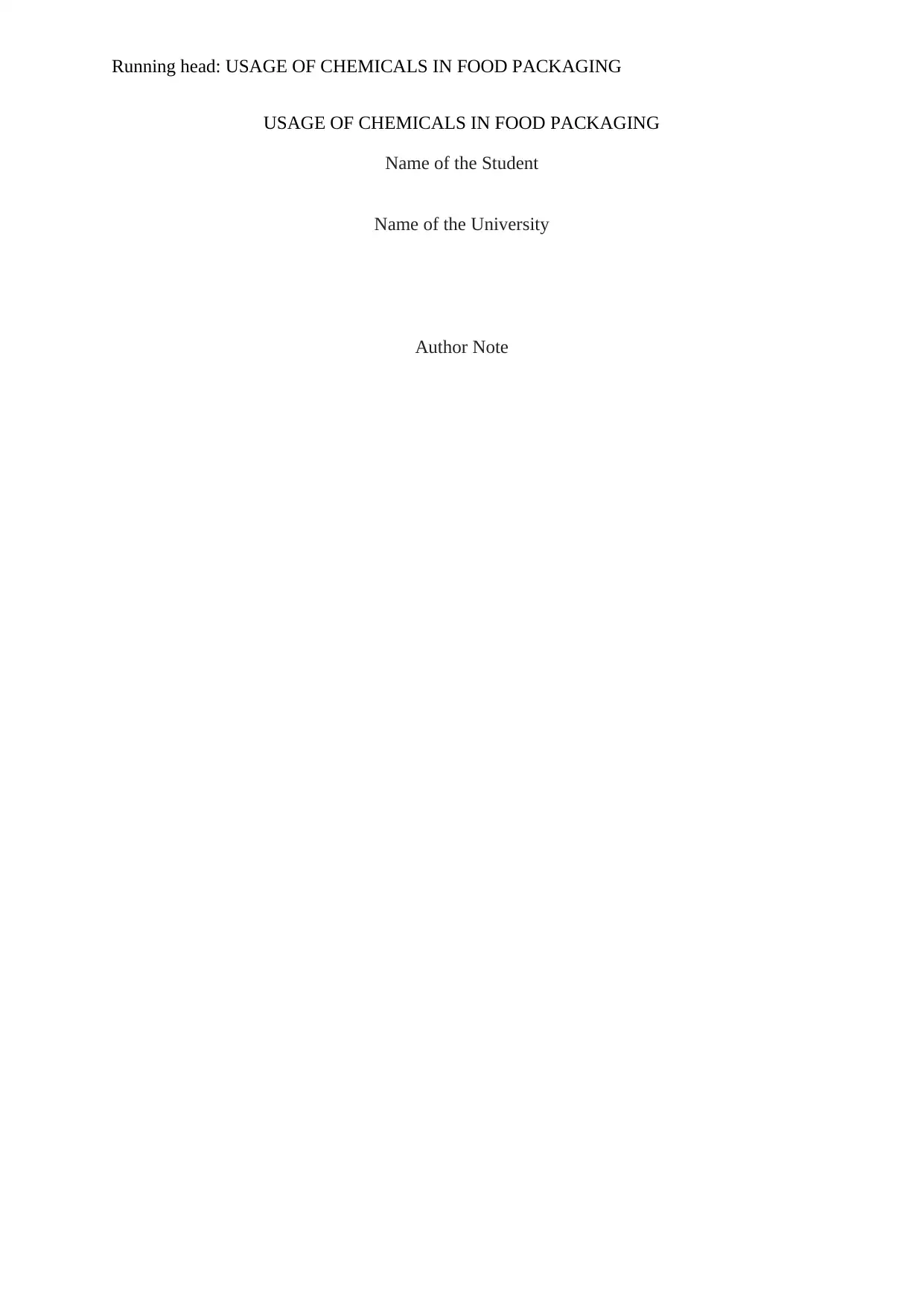
Running head: USAGE OF CHEMICALS IN FOOD PACKAGING
USAGE OF CHEMICALS IN FOOD PACKAGING
Name of the Student
Name of the University
Author Note
USAGE OF CHEMICALS IN FOOD PACKAGING
Name of the Student
Name of the University
Author Note
Paraphrase This Document
Need a fresh take? Get an instant paraphrase of this document with our AI Paraphraser
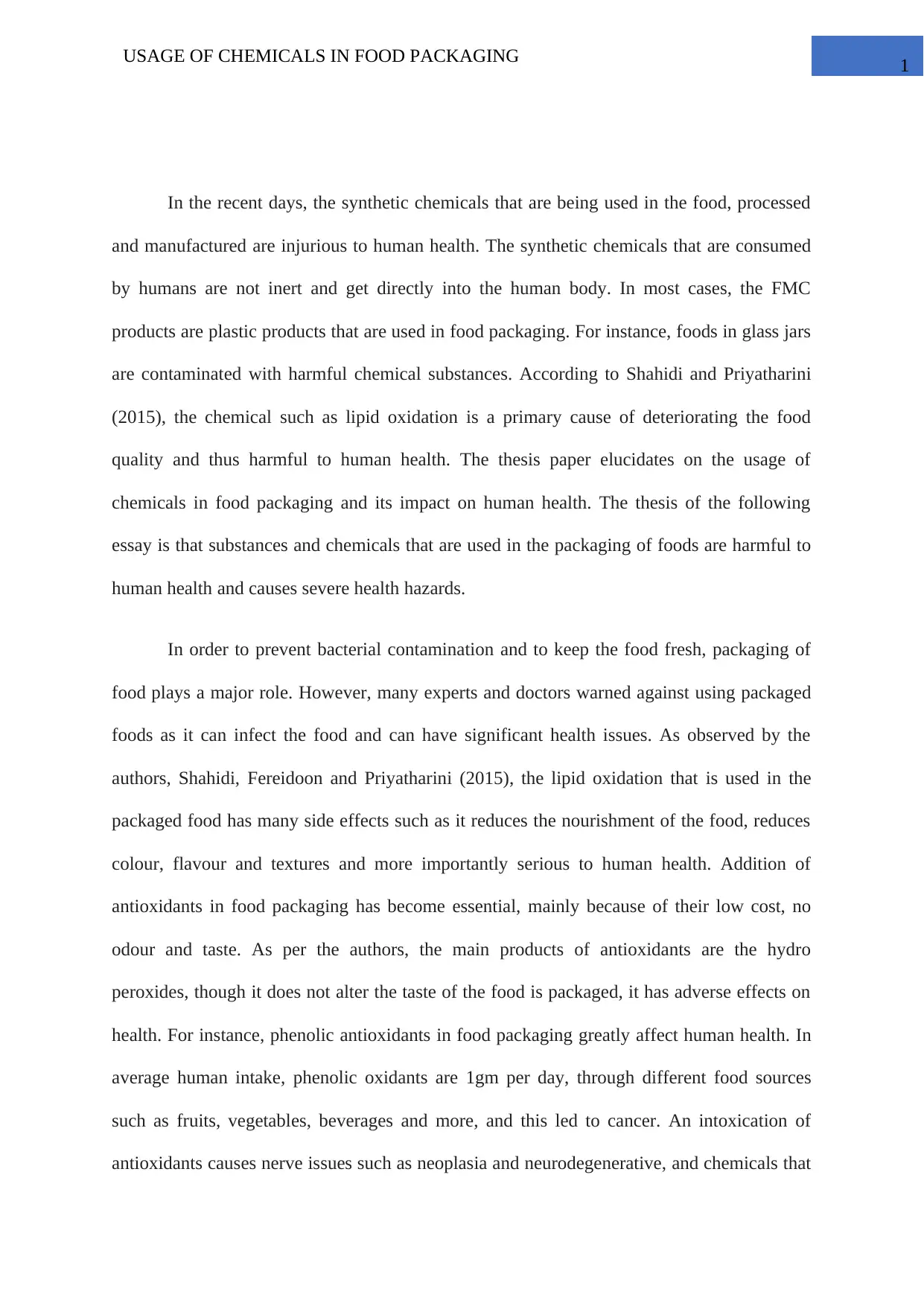
1USAGE OF CHEMICALS IN FOOD PACKAGING
In the recent days, the synthetic chemicals that are being used in the food, processed
and manufactured are injurious to human health. The synthetic chemicals that are consumed
by humans are not inert and get directly into the human body. In most cases, the FMC
products are plastic products that are used in food packaging. For instance, foods in glass jars
are contaminated with harmful chemical substances. According to Shahidi and Priyatharini
(2015), the chemical such as lipid oxidation is a primary cause of deteriorating the food
quality and thus harmful to human health. The thesis paper elucidates on the usage of
chemicals in food packaging and its impact on human health. The thesis of the following
essay is that substances and chemicals that are used in the packaging of foods are harmful to
human health and causes severe health hazards.
In order to prevent bacterial contamination and to keep the food fresh, packaging of
food plays a major role. However, many experts and doctors warned against using packaged
foods as it can infect the food and can have significant health issues. As observed by the
authors, Shahidi, Fereidoon and Priyatharini (2015), the lipid oxidation that is used in the
packaged food has many side effects such as it reduces the nourishment of the food, reduces
colour, flavour and textures and more importantly serious to human health. Addition of
antioxidants in food packaging has become essential, mainly because of their low cost, no
odour and taste. As per the authors, the main products of antioxidants are the hydro
peroxides, though it does not alter the taste of the food is packaged, it has adverse effects on
health. For instance, phenolic antioxidants in food packaging greatly affect human health. In
average human intake, phenolic oxidants are 1gm per day, through different food sources
such as fruits, vegetables, beverages and more, and this led to cancer. An intoxication of
antioxidants causes nerve issues such as neoplasia and neurodegenerative, and chemicals that
In the recent days, the synthetic chemicals that are being used in the food, processed
and manufactured are injurious to human health. The synthetic chemicals that are consumed
by humans are not inert and get directly into the human body. In most cases, the FMC
products are plastic products that are used in food packaging. For instance, foods in glass jars
are contaminated with harmful chemical substances. According to Shahidi and Priyatharini
(2015), the chemical such as lipid oxidation is a primary cause of deteriorating the food
quality and thus harmful to human health. The thesis paper elucidates on the usage of
chemicals in food packaging and its impact on human health. The thesis of the following
essay is that substances and chemicals that are used in the packaging of foods are harmful to
human health and causes severe health hazards.
In order to prevent bacterial contamination and to keep the food fresh, packaging of
food plays a major role. However, many experts and doctors warned against using packaged
foods as it can infect the food and can have significant health issues. As observed by the
authors, Shahidi, Fereidoon and Priyatharini (2015), the lipid oxidation that is used in the
packaged food has many side effects such as it reduces the nourishment of the food, reduces
colour, flavour and textures and more importantly serious to human health. Addition of
antioxidants in food packaging has become essential, mainly because of their low cost, no
odour and taste. As per the authors, the main products of antioxidants are the hydro
peroxides, though it does not alter the taste of the food is packaged, it has adverse effects on
health. For instance, phenolic antioxidants in food packaging greatly affect human health. In
average human intake, phenolic oxidants are 1gm per day, through different food sources
such as fruits, vegetables, beverages and more, and this led to cancer. An intoxication of
antioxidants causes nerve issues such as neoplasia and neurodegenerative, and chemicals that
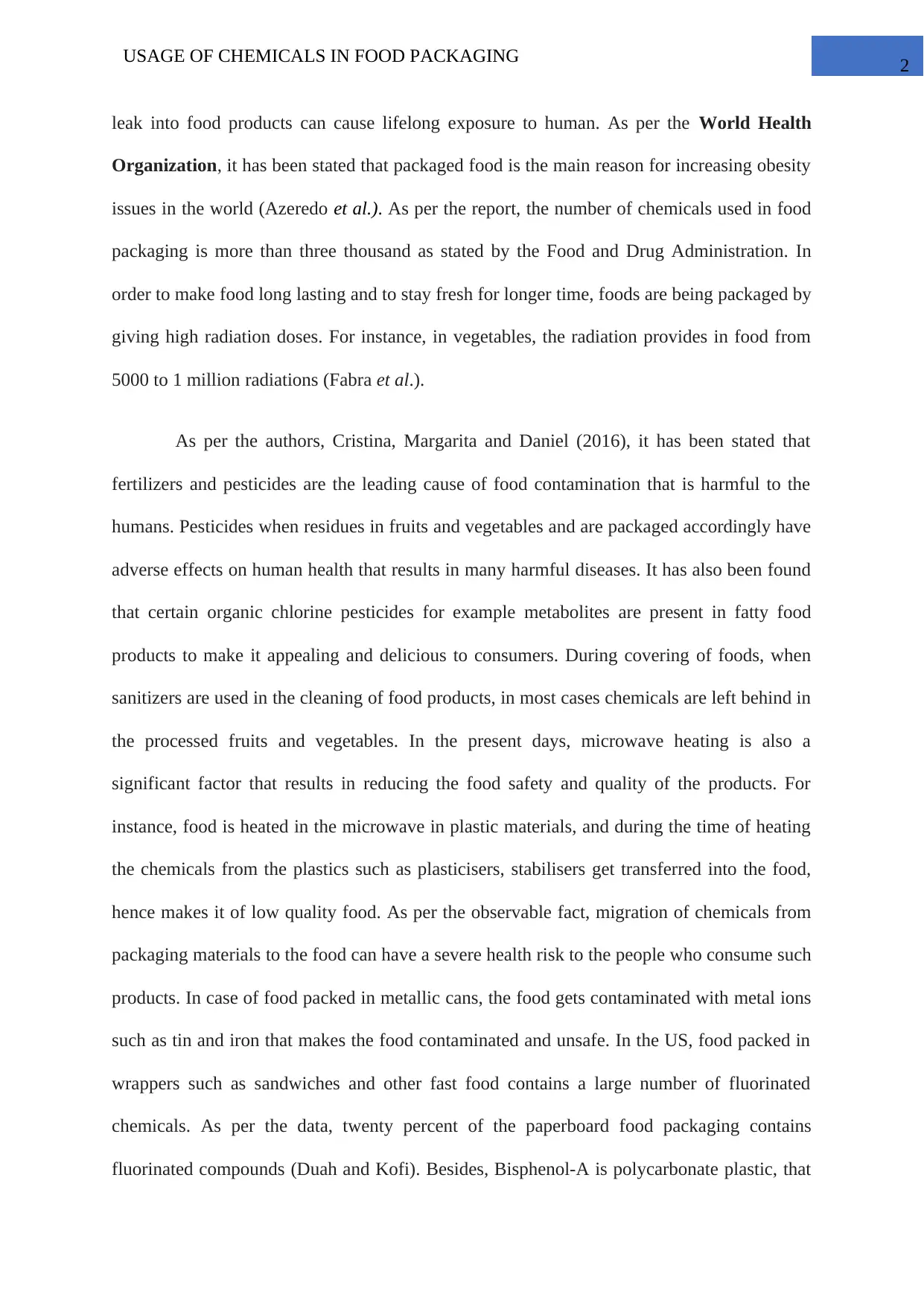
2USAGE OF CHEMICALS IN FOOD PACKAGING
leak into food products can cause lifelong exposure to human. As per the World Health
Organization, it has been stated that packaged food is the main reason for increasing obesity
issues in the world (Azeredo et al.). As per the report, the number of chemicals used in food
packaging is more than three thousand as stated by the Food and Drug Administration. In
order to make food long lasting and to stay fresh for longer time, foods are being packaged by
giving high radiation doses. For instance, in vegetables, the radiation provides in food from
5000 to 1 million radiations (Fabra et al.).
As per the authors, Cristina, Margarita and Daniel (2016), it has been stated that
fertilizers and pesticides are the leading cause of food contamination that is harmful to the
humans. Pesticides when residues in fruits and vegetables and are packaged accordingly have
adverse effects on human health that results in many harmful diseases. It has also been found
that certain organic chlorine pesticides for example metabolites are present in fatty food
products to make it appealing and delicious to consumers. During covering of foods, when
sanitizers are used in the cleaning of food products, in most cases chemicals are left behind in
the processed fruits and vegetables. In the present days, microwave heating is also a
significant factor that results in reducing the food safety and quality of the products. For
instance, food is heated in the microwave in plastic materials, and during the time of heating
the chemicals from the plastics such as plasticisers, stabilisers get transferred into the food,
hence makes it of low quality food. As per the observable fact, migration of chemicals from
packaging materials to the food can have a severe health risk to the people who consume such
products. In case of food packed in metallic cans, the food gets contaminated with metal ions
such as tin and iron that makes the food contaminated and unsafe. In the US, food packed in
wrappers such as sandwiches and other fast food contains a large number of fluorinated
chemicals. As per the data, twenty percent of the paperboard food packaging contains
fluorinated compounds (Duah and Kofi). Besides, Bisphenol-A is polycarbonate plastic, that
leak into food products can cause lifelong exposure to human. As per the World Health
Organization, it has been stated that packaged food is the main reason for increasing obesity
issues in the world (Azeredo et al.). As per the report, the number of chemicals used in food
packaging is more than three thousand as stated by the Food and Drug Administration. In
order to make food long lasting and to stay fresh for longer time, foods are being packaged by
giving high radiation doses. For instance, in vegetables, the radiation provides in food from
5000 to 1 million radiations (Fabra et al.).
As per the authors, Cristina, Margarita and Daniel (2016), it has been stated that
fertilizers and pesticides are the leading cause of food contamination that is harmful to the
humans. Pesticides when residues in fruits and vegetables and are packaged accordingly have
adverse effects on human health that results in many harmful diseases. It has also been found
that certain organic chlorine pesticides for example metabolites are present in fatty food
products to make it appealing and delicious to consumers. During covering of foods, when
sanitizers are used in the cleaning of food products, in most cases chemicals are left behind in
the processed fruits and vegetables. In the present days, microwave heating is also a
significant factor that results in reducing the food safety and quality of the products. For
instance, food is heated in the microwave in plastic materials, and during the time of heating
the chemicals from the plastics such as plasticisers, stabilisers get transferred into the food,
hence makes it of low quality food. As per the observable fact, migration of chemicals from
packaging materials to the food can have a severe health risk to the people who consume such
products. In case of food packed in metallic cans, the food gets contaminated with metal ions
such as tin and iron that makes the food contaminated and unsafe. In the US, food packed in
wrappers such as sandwiches and other fast food contains a large number of fluorinated
chemicals. As per the data, twenty percent of the paperboard food packaging contains
fluorinated compounds (Duah and Kofi). Besides, Bisphenol-A is polycarbonate plastic, that
⊘ This is a preview!⊘
Do you want full access?
Subscribe today to unlock all pages.

Trusted by 1+ million students worldwide
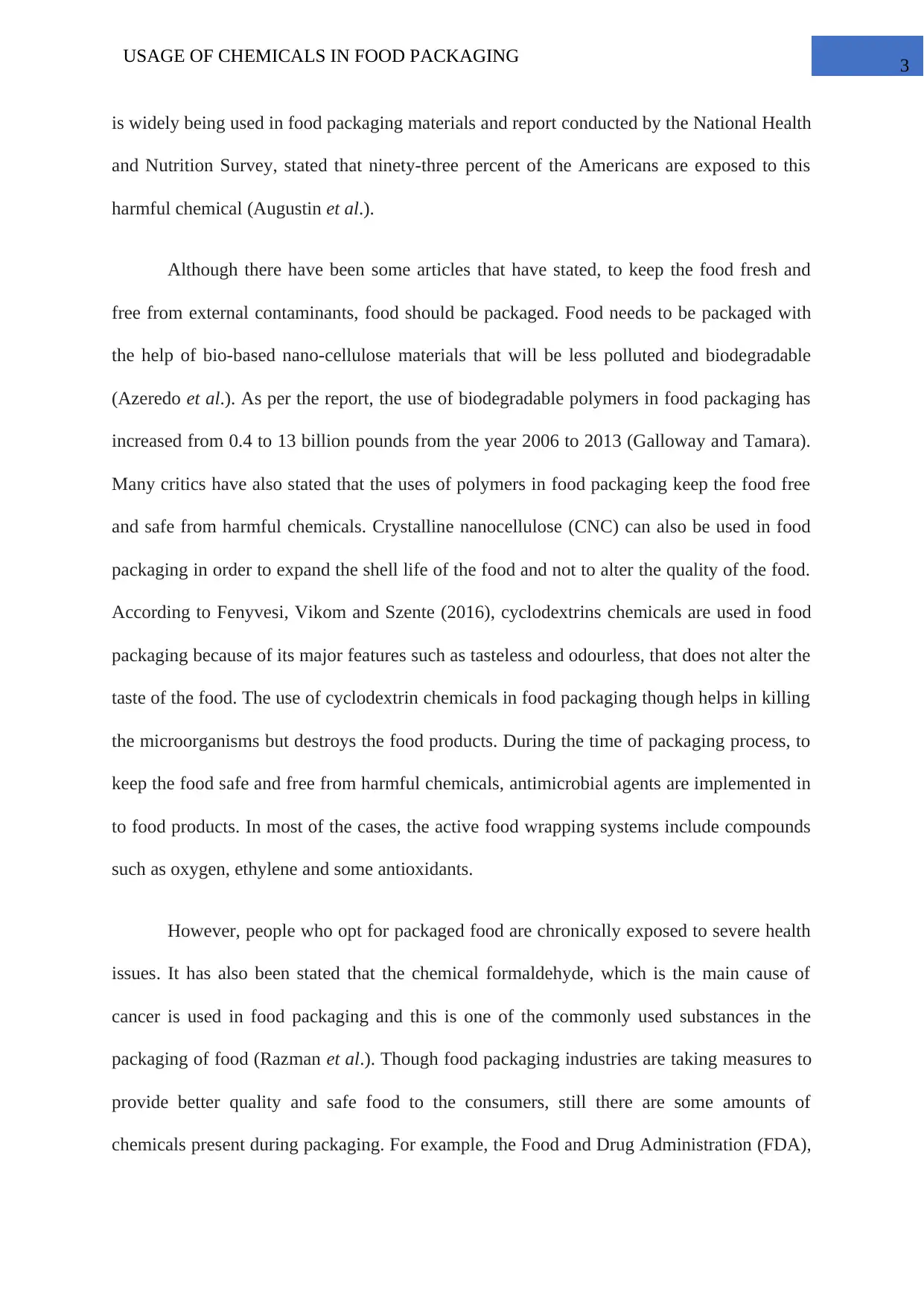
3USAGE OF CHEMICALS IN FOOD PACKAGING
is widely being used in food packaging materials and report conducted by the National Health
and Nutrition Survey, stated that ninety-three percent of the Americans are exposed to this
harmful chemical (Augustin et al.).
Although there have been some articles that have stated, to keep the food fresh and
free from external contaminants, food should be packaged. Food needs to be packaged with
the help of bio-based nano-cellulose materials that will be less polluted and biodegradable
(Azeredo et al.). As per the report, the use of biodegradable polymers in food packaging has
increased from 0.4 to 13 billion pounds from the year 2006 to 2013 (Galloway and Tamara).
Many critics have also stated that the uses of polymers in food packaging keep the food free
and safe from harmful chemicals. Crystalline nanocellulose (CNC) can also be used in food
packaging in order to expand the shell life of the food and not to alter the quality of the food.
According to Fenyvesi, Vikom and Szente (2016), cyclodextrins chemicals are used in food
packaging because of its major features such as tasteless and odourless, that does not alter the
taste of the food. The use of cyclodextrin chemicals in food packaging though helps in killing
the microorganisms but destroys the food products. During the time of packaging process, to
keep the food safe and free from harmful chemicals, antimicrobial agents are implemented in
to food products. In most of the cases, the active food wrapping systems include compounds
such as oxygen, ethylene and some antioxidants.
However, people who opt for packaged food are chronically exposed to severe health
issues. It has also been stated that the chemical formaldehyde, which is the main cause of
cancer is used in food packaging and this is one of the commonly used substances in the
packaging of food (Razman et al.). Though food packaging industries are taking measures to
provide better quality and safe food to the consumers, still there are some amounts of
chemicals present during packaging. For example, the Food and Drug Administration (FDA),
is widely being used in food packaging materials and report conducted by the National Health
and Nutrition Survey, stated that ninety-three percent of the Americans are exposed to this
harmful chemical (Augustin et al.).
Although there have been some articles that have stated, to keep the food fresh and
free from external contaminants, food should be packaged. Food needs to be packaged with
the help of bio-based nano-cellulose materials that will be less polluted and biodegradable
(Azeredo et al.). As per the report, the use of biodegradable polymers in food packaging has
increased from 0.4 to 13 billion pounds from the year 2006 to 2013 (Galloway and Tamara).
Many critics have also stated that the uses of polymers in food packaging keep the food free
and safe from harmful chemicals. Crystalline nanocellulose (CNC) can also be used in food
packaging in order to expand the shell life of the food and not to alter the quality of the food.
According to Fenyvesi, Vikom and Szente (2016), cyclodextrins chemicals are used in food
packaging because of its major features such as tasteless and odourless, that does not alter the
taste of the food. The use of cyclodextrin chemicals in food packaging though helps in killing
the microorganisms but destroys the food products. During the time of packaging process, to
keep the food safe and free from harmful chemicals, antimicrobial agents are implemented in
to food products. In most of the cases, the active food wrapping systems include compounds
such as oxygen, ethylene and some antioxidants.
However, people who opt for packaged food are chronically exposed to severe health
issues. It has also been stated that the chemical formaldehyde, which is the main cause of
cancer is used in food packaging and this is one of the commonly used substances in the
packaging of food (Razman et al.). Though food packaging industries are taking measures to
provide better quality and safe food to the consumers, still there are some amounts of
chemicals present during packaging. For example, the Food and Drug Administration (FDA),
Paraphrase This Document
Need a fresh take? Get an instant paraphrase of this document with our AI Paraphraser
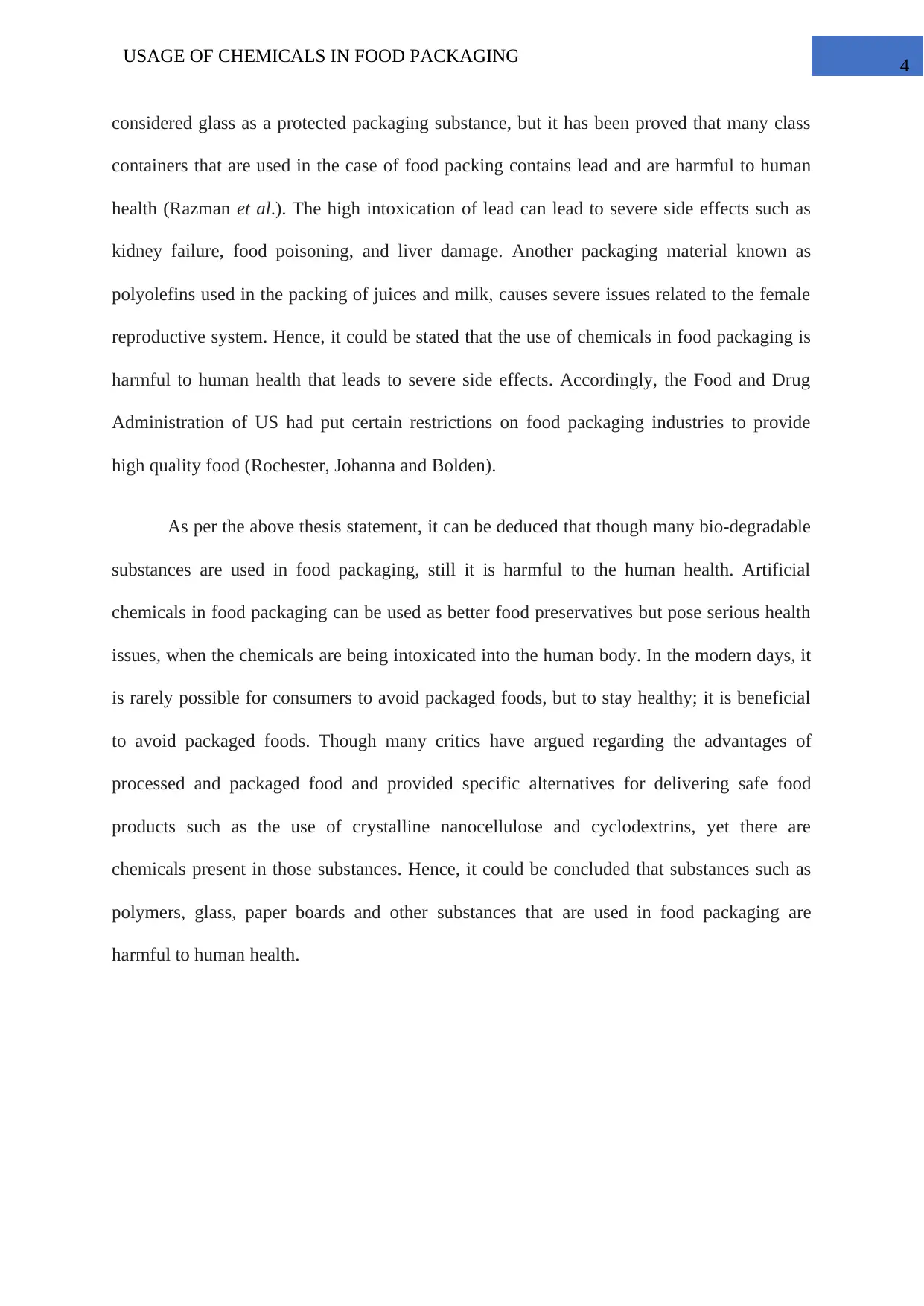
4USAGE OF CHEMICALS IN FOOD PACKAGING
considered glass as a protected packaging substance, but it has been proved that many class
containers that are used in the case of food packing contains lead and are harmful to human
health (Razman et al.). The high intoxication of lead can lead to severe side effects such as
kidney failure, food poisoning, and liver damage. Another packaging material known as
polyolefins used in the packing of juices and milk, causes severe issues related to the female
reproductive system. Hence, it could be stated that the use of chemicals in food packaging is
harmful to human health that leads to severe side effects. Accordingly, the Food and Drug
Administration of US had put certain restrictions on food packaging industries to provide
high quality food (Rochester, Johanna and Bolden).
As per the above thesis statement, it can be deduced that though many bio-degradable
substances are used in food packaging, still it is harmful to the human health. Artificial
chemicals in food packaging can be used as better food preservatives but pose serious health
issues, when the chemicals are being intoxicated into the human body. In the modern days, it
is rarely possible for consumers to avoid packaged foods, but to stay healthy; it is beneficial
to avoid packaged foods. Though many critics have argued regarding the advantages of
processed and packaged food and provided specific alternatives for delivering safe food
products such as the use of crystalline nanocellulose and cyclodextrins, yet there are
chemicals present in those substances. Hence, it could be concluded that substances such as
polymers, glass, paper boards and other substances that are used in food packaging are
harmful to human health.
considered glass as a protected packaging substance, but it has been proved that many class
containers that are used in the case of food packing contains lead and are harmful to human
health (Razman et al.). The high intoxication of lead can lead to severe side effects such as
kidney failure, food poisoning, and liver damage. Another packaging material known as
polyolefins used in the packing of juices and milk, causes severe issues related to the female
reproductive system. Hence, it could be stated that the use of chemicals in food packaging is
harmful to human health that leads to severe side effects. Accordingly, the Food and Drug
Administration of US had put certain restrictions on food packaging industries to provide
high quality food (Rochester, Johanna and Bolden).
As per the above thesis statement, it can be deduced that though many bio-degradable
substances are used in food packaging, still it is harmful to the human health. Artificial
chemicals in food packaging can be used as better food preservatives but pose serious health
issues, when the chemicals are being intoxicated into the human body. In the modern days, it
is rarely possible for consumers to avoid packaged foods, but to stay healthy; it is beneficial
to avoid packaged foods. Though many critics have argued regarding the advantages of
processed and packaged food and provided specific alternatives for delivering safe food
products such as the use of crystalline nanocellulose and cyclodextrins, yet there are
chemicals present in those substances. Hence, it could be concluded that substances such as
polymers, glass, paper boards and other substances that are used in food packaging are
harmful to human health.
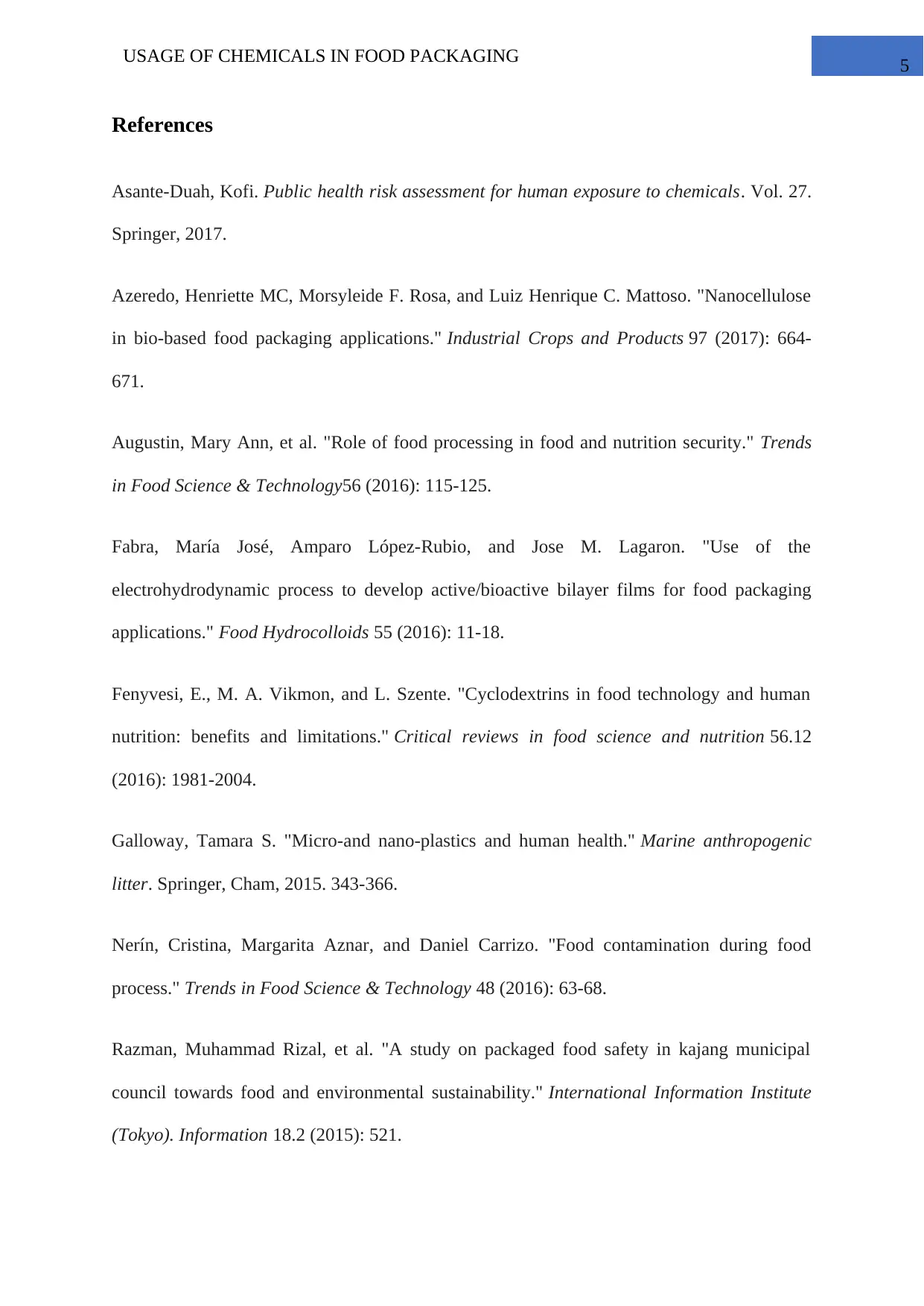
5USAGE OF CHEMICALS IN FOOD PACKAGING
References
Asante-Duah, Kofi. Public health risk assessment for human exposure to chemicals. Vol. 27.
Springer, 2017.
Azeredo, Henriette MC, Morsyleide F. Rosa, and Luiz Henrique C. Mattoso. "Nanocellulose
in bio-based food packaging applications." Industrial Crops and Products 97 (2017): 664-
671.
Augustin, Mary Ann, et al. "Role of food processing in food and nutrition security." Trends
in Food Science & Technology56 (2016): 115-125.
Fabra, María José, Amparo López-Rubio, and Jose M. Lagaron. "Use of the
electrohydrodynamic process to develop active/bioactive bilayer films for food packaging
applications." Food Hydrocolloids 55 (2016): 11-18.
Fenyvesi, E., M. A. Vikmon, and L. Szente. "Cyclodextrins in food technology and human
nutrition: benefits and limitations." Critical reviews in food science and nutrition 56.12
(2016): 1981-2004.
Galloway, Tamara S. "Micro-and nano-plastics and human health." Marine anthropogenic
litter. Springer, Cham, 2015. 343-366.
Nerín, Cristina, Margarita Aznar, and Daniel Carrizo. "Food contamination during food
process." Trends in Food Science & Technology 48 (2016): 63-68.
Razman, Muhammad Rizal, et al. "A study on packaged food safety in kajang municipal
council towards food and environmental sustainability." International Information Institute
(Tokyo). Information 18.2 (2015): 521.
References
Asante-Duah, Kofi. Public health risk assessment for human exposure to chemicals. Vol. 27.
Springer, 2017.
Azeredo, Henriette MC, Morsyleide F. Rosa, and Luiz Henrique C. Mattoso. "Nanocellulose
in bio-based food packaging applications." Industrial Crops and Products 97 (2017): 664-
671.
Augustin, Mary Ann, et al. "Role of food processing in food and nutrition security." Trends
in Food Science & Technology56 (2016): 115-125.
Fabra, María José, Amparo López-Rubio, and Jose M. Lagaron. "Use of the
electrohydrodynamic process to develop active/bioactive bilayer films for food packaging
applications." Food Hydrocolloids 55 (2016): 11-18.
Fenyvesi, E., M. A. Vikmon, and L. Szente. "Cyclodextrins in food technology and human
nutrition: benefits and limitations." Critical reviews in food science and nutrition 56.12
(2016): 1981-2004.
Galloway, Tamara S. "Micro-and nano-plastics and human health." Marine anthropogenic
litter. Springer, Cham, 2015. 343-366.
Nerín, Cristina, Margarita Aznar, and Daniel Carrizo. "Food contamination during food
process." Trends in Food Science & Technology 48 (2016): 63-68.
Razman, Muhammad Rizal, et al. "A study on packaged food safety in kajang municipal
council towards food and environmental sustainability." International Information Institute
(Tokyo). Information 18.2 (2015): 521.
⊘ This is a preview!⊘
Do you want full access?
Subscribe today to unlock all pages.

Trusted by 1+ million students worldwide
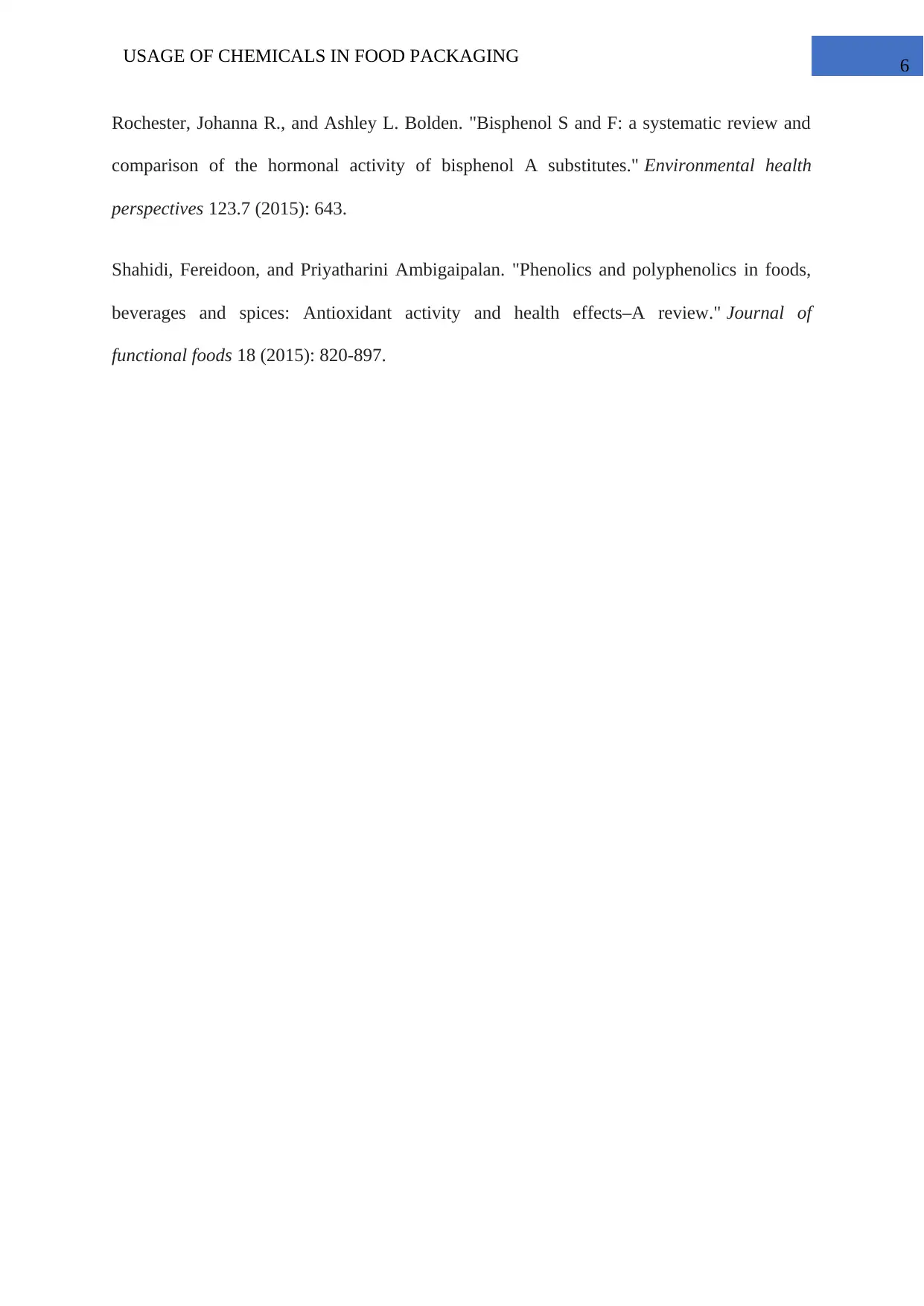
6USAGE OF CHEMICALS IN FOOD PACKAGING
Rochester, Johanna R., and Ashley L. Bolden. "Bisphenol S and F: a systematic review and
comparison of the hormonal activity of bisphenol A substitutes." Environmental health
perspectives 123.7 (2015): 643.
Shahidi, Fereidoon, and Priyatharini Ambigaipalan. "Phenolics and polyphenolics in foods,
beverages and spices: Antioxidant activity and health effects–A review." Journal of
functional foods 18 (2015): 820-897.
Rochester, Johanna R., and Ashley L. Bolden. "Bisphenol S and F: a systematic review and
comparison of the hormonal activity of bisphenol A substitutes." Environmental health
perspectives 123.7 (2015): 643.
Shahidi, Fereidoon, and Priyatharini Ambigaipalan. "Phenolics and polyphenolics in foods,
beverages and spices: Antioxidant activity and health effects–A review." Journal of
functional foods 18 (2015): 820-897.
Paraphrase This Document
Need a fresh take? Get an instant paraphrase of this document with our AI Paraphraser
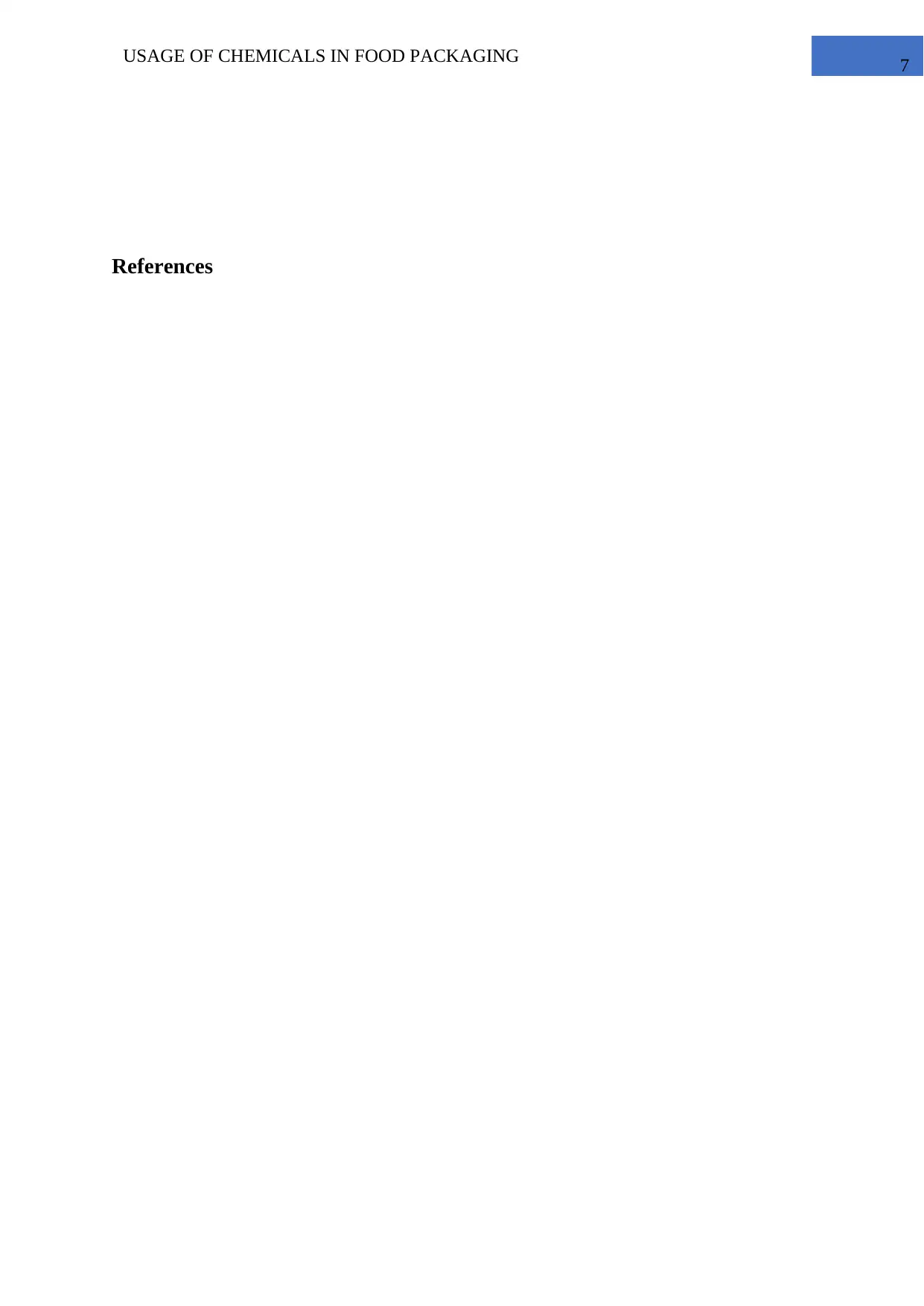
7USAGE OF CHEMICALS IN FOOD PACKAGING
References
References
1 out of 8
Your All-in-One AI-Powered Toolkit for Academic Success.
+13062052269
info@desklib.com
Available 24*7 on WhatsApp / Email
![[object Object]](/_next/static/media/star-bottom.7253800d.svg)
Unlock your academic potential
Copyright © 2020–2025 A2Z Services. All Rights Reserved. Developed and managed by ZUCOL.
